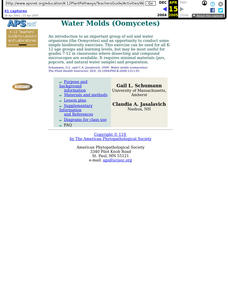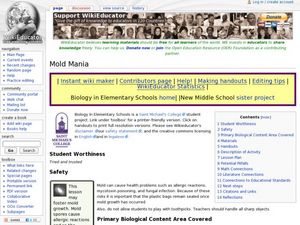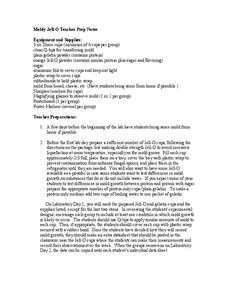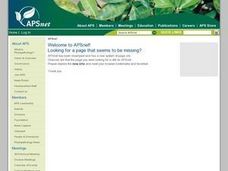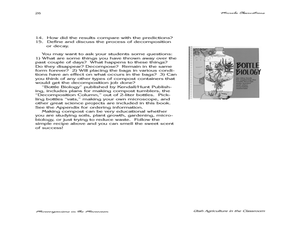Curated OER
Water Molds (Oomycetes)
Students research a group of fungus-like organisms; the Oomycetes, by baiting them from natural sources (water and soil) and observing them.
Curated OER
Protists
In this protists worksheet, students will read about the different kinds of protists including protozoans, algae, and molds. Students will then complete 2 short answer questions and 1 true or false question.
University of Hawaiʻi
Taxonomy and Me!
Taxonomy is the study of organisms and how you phylum. Three biology activities are included, helping scholars understand four of the six kingdoms, specifically Protista, Plantae, Fungi, and Animalia. Scholars observe and classify...
Curated OER
Primary Biological Content Area Covered
Young scholars use the scientific method to make predictions about mold growth. In this fungus lesson plan, students use worksheets to help them illustrate predictions and graph mold growth from white to wheat bread. Young scholars first...
Curated OER
Diversity of Life
Students study fungi and its characteristics. In this fungi lesson students collect and observe fungi then answer questions on what they saw.
Curated OER
Moldy Jell-O
Students design an experiment to determine the best conditions for molds growth. In this biology lesson, students collect data for a week and analyze their findings. They create a presentation and share them with the class.
Curated OER
Fossil Impressions of Ancient Life
Students make a mold using Plaster of Paris and then make a cast using that same mold. They pick a fossil and describe how it looks. They write a fictionalized story about its life, or burial. (
Curated OER
Kitchen Garbage: Food For Thought
In this fungi and food matching instructional activity, students draw lines to match different types of fungi such as yeast and mold, and with the foods that they affect.
Curated OER
Mushroom Prints
Students create a mushroom spore design on paper while studying the facts on fungi.
Curated OER
Yeasts and Molds: Food Science, Bacteria, Fungi
For this lesson students will consider the characteristics and nature of yeast and molds in order to help them understand how these microorganisms affect food production.
Curated OER
Water Molds (Oomycetes)
Students explore a group of fungus-like organisms; the Oomycetes, by baiting them from natural sources (water and soil) and observing them.
Curated OER
Spud Smear
Students study various samples of microorganisms in petri dishes. For this microorganism lesson, students place various samples of items in petri dishes and observe them after several days of incubation.
Virginia Department of Education
Organisms in Symbiosis
Searching for an activity that allows emerging biologists to explore symbiosis up close and personal? Pupils collect samples and view lichens through a microscope and conclude with a discussion about the relationship they have...
Biology Junction
Protists: The World of Protists
More than 200,000 species of protists exist, living on land and in water around the planet. Scholars view the diversity of protists in an interesting presentation. It divides protists into three groups: animal-like protists, plant-like...
Curated OER
What's That Brown Fuzzy Stuff On My Plum?
Students examine Koch's Postulates by actually using them. They perform each of the required four steps to show that the brown fuzzy fungus they see growing on stone fruit (plums, peaches, nectarines, cherries) is what causes them to rot.
Curated OER
Fungal History
Students identify different types of fungi. They discuss how mushrooms are used in American culture and research an issue about a type of fungi. They share their information with the class.
Curated OER
The Nature and Science of Technology
Fifth graders practice using the scientific method by observing and creating mold. In this bacteria lesson, 5th graders experiment creating their own mold and fungus using petri dishes and oatmeal. Students create an...
Curated OER
Protists
For this protists worksheet, learners compare and contrast the different types of funguslike protists: slime molds, water molds, and downy mildews. This worksheet has 1 short answer and 7 fill in the blank questions.
Curated OER
Protists
In this protists worksheet, students will use idea maps about plantlike protist and funguslike protist characteristics to complete 4 short answer questions.
Curated OER
Diseases
Sixth graders create a type of notebook or journal using colored copy paper on which to take notes. They complete research on a certain disease and report on it and then design their own disease causing bacteria or virus. Finally, 6th...
Curated OER
Rotten Truth
Pupils complete activities to study decomposition. For this decomposition lesson, students work in pairs to observe a decay buffet experiment. Pupils keep compost bag journals. Students define and discuss the process of decomposition.
Curated OER
Classy
Students explore the classification system in this seven lessons unit. The diversity of life forms and their characteristics are examined using a microscope. Kingdoms, classes, and families are investigated.
Curated OER
Discovering the Forgotten Kingdom Protista
Protists, like algae and mold, are sometimes overlooked for classroom study, but they are astonishing in their diversity and importance.
Cornell University
Bacteria Take Over and Down
Bacteria outnumber all other forms of life on Earth. Scholars observe the growth of bacteria in petri dishes to understand their role in maintaining good health. Then, they observe the growth of bacteria after they introduce...
